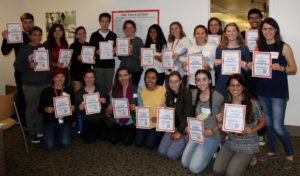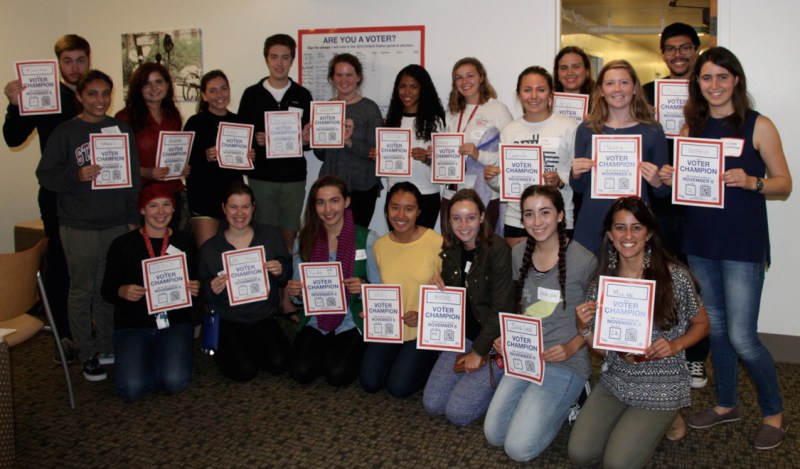The newly-launched Stanford Voter Project is giving students more reason to vote by getting their dorm mates involved in voter registration drives. Founders Mulan MacDougall ’18 and Sophia Pink ’19 took the initiative from the drawing board to the residence halls after conceiving of the idea in a d.school class taught by lecturer Cynthia Benjamin B.S. ’85 M.S. ’88.

“We’re trying to transform voting from a solitary chore to a community activity,” Pink said.
Called ME 105: “Designing for Impact,” the class focused on increasing student voter participation at Stanford. With the help of Benjamin, MacDougall and Pink sought funding from the Haas Centre for Public Service, the product design department at Stanford and Stanford in Government (SIG) to get their project off the ground.
MacDougall and Pink interviewed other students and looked at research by social scientists about why people vote or don’t vote. In their research, Pink and MacDougall found that lack of community support and accountability were the two things that most hindered student participation. Most students did not have much of an idea about whether their peers were registered voters or not because of a dearth of conversation about voting.
Another problem was missing public accountability. Even though students register to vote, many of them do not stay interested enough to actually go to the polling booths come election day.
Most students at Stanford leave their home state to attend college and many of them are first-time voters. Additionally, according to Pink and MacDougall, voting becomes harder in college because so many students have to request absentee ballots and do not see voting as a norm. Different states have different laws, and many students find the voting process daunting as a result.
In response, the Stanford Voting Project recruited “voter champions” in each residence hall to assist students in the process of registration, requesting an absentee ballot and providing any other information about voting procedures.
As a first step, voter champions conduct a survey in their own dorm, asking people if they registered to vote or not.
In addition to providing information, the Stanford Voter Project also aims to increase accountability among students by hanging up posters proclaiming “I am a registered voter” and “I promise to vote in the 2016 election” in dorms for students to sign. Personalized signs on residents’ doors also create positive peer pressure for other students in the residential community to vote.
A Twain resident who declined to be named appreciated the greater accessibility the Stanford Voter Projects brings to voting.
“It is especially good that they’re coming to the dorms, because many students don’t know about the process,” the student said. “They also make you register there and then, which is super helpful.”
Ellie Utter ’19, who serves as voter champion for Twain, was heartened by her fellow residents’ response.
“Everyone in the dorm is so excited about the election. Everyone has so many questions,” Utter said.
MacDougall and Pink say that their project is based in large part on psychology research done at Stanford. For example, Stanford psychologists found that tying voting to people’s identity increased the chance that they would vote in an election.
“We want to show voting as a norm because if you can establish something as a norm and show that, then people are more likely to follow with it,” MacDougall explained.
The project is currently focused primarily on increasing voter participation in the November presidential elections. After the elections, Pink and MacDougall will evaluate the effectiveness of their work and possibly expand their project to other college campuses. They especially hope to reach swing states where youth voter participation can have a huge impact on the results.
Contact Simar Malhorta at simar ‘at’ stanford.edu
